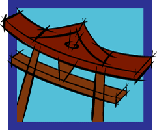| |
 Japan—Land
and People Japan—Land
and People
Japan stretches between approximately
the same latitudes as the contiguous United States, from 20° to 45°
N Latitude. It is made up of four main islands—Hokkaido, Honshu,
Shikoku, and Kyushu—and hundreds of smaller islands, including Okinawa.
Population
Japan has a population of 127.1
(2001 census), roughly half the population of the U.S., but with only
one twenty-sixth the land area. This comes out to roughly 872 people per
square mile in Japan, compared with 77 in the States. Furthermore, 85%
of Japan’s 145,880 square miles (377,829 sq. km.) is considered
to be mountainous, so while the country’s size is similar to that
of Montana, most of Japan’s population is crammed into 15% of its
land area, which comes out to a population density of 5,808 people per
square mile—18,000 per sq. mile in Tokyo. This is why you can reach
out your window and shake hands with your next-door neighbor.
Climate
Japan ranges in climate from
the pleasant summers and cold, snowy winters of Hokkaido to the subtropical
heat and humidity of Okinawa—analogous to the climate variations
along the U.S. East Coast from Maine to Florida. Snow in Japan tends to
be heaviest in Hokkaido and the western side of Honshu, facing the Sea
of Japan; the backbone of mountains running through central Japan keeps
heavy snows from reaching the Pacific side.
Winters in the Kanto area (which
includes Tokyo) seldom get much colder than 30°F, which may sound
reasonable if you’re used to subzero temperatures—but remember,
Japanese houses generally don’t have central heating or sufficient
insulation. Further, most Japanese turn off their heaters at night for
fear of starting a fire; 30° seems much colder when you’re in
your pajamas. Winter days are generally cold and clear.
Japan (except Hokkaido) has
a rainy season in June and July. This is closely followed by the typhoon
season, when tropical cyclones may hit any part of Japan. Otherwise, get
set for a hot, muggy summer. Temperatures are often in the 90s F.
Society
Many foreigners
coming to Japan still have in their minds pictures of a Japan where people
live in harmony with nature, where kabuki and Zen Buddhism are well known
among the general population. Especially for those who go to Tokyo or
Osaka, that pleasant picture is soon shattered by the grimy realities
of modern Japan (as documented in Alex Kerr’s book Dogs and
Demons ), and the realization that Japanese are more likely to be
familiar with Mozart or Shakespeare than koto master Yatsuhashi Kengyo
or bunraku and kabuki playwright Chikamatsu Monzaemon. Still, the traditional
Japan can be found if you look for it; as one of my college professors
liked to say, this is a society that doesn’t throw anything away.
While Japan may outwardly appear
to have bought into Western culture wholesale, the ways of thinking are
still uniquely Japanese. This can take a while to grasp; the U.S. government
still hasn’t. Japan’s social structure is based on rigid heirarchy
and conformity to one’s group. This seems to be eroding somewhat,
but there is no reason to think that Japan’s social—or economic—structure
will ever mirror our own.
View from
Japan home
|


 This page last updated
June 18, 2005
. E-mail Tim
This page last updated
June 18, 2005
. E-mail Tim